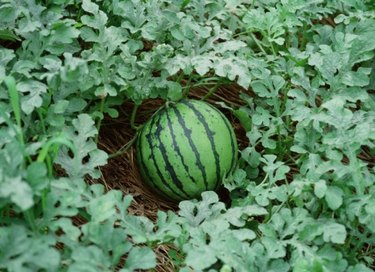
Gardeners raise watermelons on vining plants growing in a sunny, hot location. First planted from seed once soil temperatures are at least 65 degrees Fahrenheit, watermelon plants need at least 90 days of warm, frost-free weather to produce harvestable melon fruits. Placing developing melons atop a bed of straw, plastic sheeting or smooth piece of wood diminishes the chance for fruit rotting when in direct contact with wet soil. Ultimately, it's an optional step as melons won't rot atop the ground if the soil isn't soggy and air circulation is good.
Benefits
Video of the Day
Placing a mulch layer over the soil in the watermelon garden plot serves multiple purposes and benefits. Black plastic sheeting helps warm the soil before you sow watermelon seeds and then keeps plant parts off of soil later on. Allow soil to get above 75 degrees before you cover the entire area with organic materials like straw, dry grass clippings or bark nuggets. All of these soil coverings conserve soil moisture, eliminate weeds and help keep stems, leaves and fruits off of soil, which may harbor fungal diseases. Whichever mulch used, it needs to quickly drain rainfall or irrigation, so any growing watermelons do not sit in standing water or wet, moldy mulch conditions.
Video of the Day
Use Localized Soil Coverings
Watermelon plants prosper in rather gritty soils with organic matter and often succumb to more diseases if the soil is heavy and conditions near the ground remain highly humid. In loamy garden soil, widespread mulching may keep the soil too cool or moist. Instead, place small patches of plastic sheeting, coarse straw or a piece of plywood directly under melon fruits that have become at least softball sized. As long as the melon doesn't rest directly atop wet soil or mulch, there's much less chance for the melon's underside to rot.
Insight
If your summer weather naturally is hot, not too humid and the garden soil isn't heavy, you may skip lifting up melons to place them atop a barrier to shield them from the soil. Rot occurs only when the soil surface stays too wet or leaves shade the melon and prevent air movement and soil surface drying. You may use old dinner plates to place under watermelons, but keep in mind the melon often gets longer and larger than the plate. Plate edges cause scars or deformities on the melon's underside. Avoid placing a melon atop a bucket or terracotta pot. If you use black plastic or coarse mulch, make each area about 24 inches by 24 inches so there's ample space for the melon to develop over four to six weeks.
Warning
Use care when working with and handling development watermelons and their vines. Plant roots remain rather shallow so don't compact the ground or cultivate too deeply with your feet or tools. Breaking the vine ends the growth of a watermelon. Rock the melon to place mulch under it, or partially roll it if you want to examine the rind to test for ripeness. Ripe watermelons' undersides turn pale yellow to white when ripe and any tendrils near the stem start to dry up.
- University of Illinois Extension; Watermelon; Ron Wolford and Drusilla Banks
- Utah State University Cooperative Extension; Watermelon in the Garden; Dan Drost, et al.; 2010
- University of Minnesota Extension; Growing Melons in Minnesota Home Gardens; Karl Foord, et al.; 2009
- Tropical Permaculture: Growing Watermelons
- Learn2Grow: Citrullus Lanatus